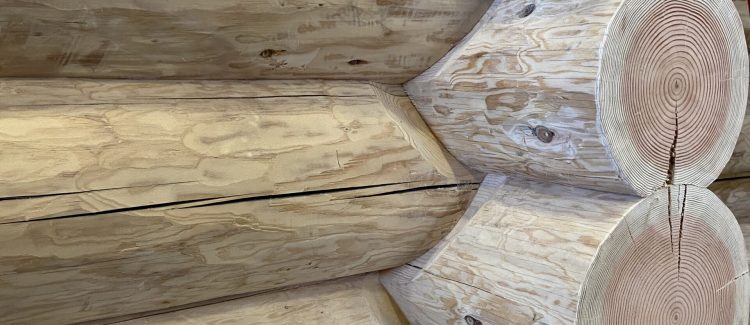
Do you have doubts about the energy efficiency of log homes? Or, perhaps, you are concerned a log home won’t measure up to the stringent building codes in your county? Either way, the good news is that the facts about log homes may surprise you!
Log Facts
- Logs are filled with densely packed fibers that have small pockets of air, commonly referred to to as grain. The grain is comprised of small tubes that the tree used to transfer water and nutrients. When the log dries, the tubes become minute air pockets.
- Because heat naturally wants to transfer towards cold, larger logs, with extra fibers and air pockets, are better at trapping heat and slowing down that transfer. Therefore, the larger the logs the more energy efficient they are.

What exactly is R-Value?
- R-value measures the resistance of a construction material to temperature transfer; i.e. value of insulation. Typically acceptable exterior wall R-value ranges from R13 to R23. Logs average 1.0 R-value per inch of thickness, so a 14″ log has an R-Value of R14. The smallest logs Caribou Creek builds with is 12″ logs, but we strongly recommend 14″ – 20″ logs.
U-Value - the Overall Picture
- As we explained, R-Value grades the resistance building materials have to heat transfer. But, when looking at homes, it would not be complete to only grade the logs. This is where U-Value comes in. U-value grades the efficiency of the entire home – the big picture – shall we say. It takes into consideration the roof, windows, doors, quality and style of log construction, as well as roof insulation.

How did log homes get a bad rep?
When discussing modern energy efficiency standards, log homes are not often the first construction method that comes to mind. This is in part because they are not very common, and also, they have developed a reputation for such things as “being drafty.” Log homes of yesteryear, that were built using mostly green or dead standing logs, had a lot more settling and log movement that contributed to these common problems.
However, log homes of the modern era are not built in the same fashion. Most log home companies today have a higher standard of fiber choice and construction method thus decreasing the draftiness of their predecessors.
Advancements in chinking material, non-settling construction design, and enhancements to log drying have increased the tightness of log homes.
Additionally, improvements in roofing and insulation materials, coupled with advancements in window quality have all contributed to the overall energy efficiency.
What the experts say.
The Department of Energy conducted a lengthy study on energy efficiency of mass walls compared to framed walls. (If you would like to read the study findings click here.)
The study concludes, “Log walls, despite lower-appearing steady-state R-values, have been shown to provide equal or superior annual heating and cooling performance when compared to lightweight wood frame walls of higher steady- state R-values. Example: a log wall with a calculated steady-state R-9 value performs similarly for both heating and A/C loads to an R-13 to R-15 insulated lightweight wood frame wall in a temperate climate”
Another great article to read, for anyone who likes to bug out on technical details, is written by Rob Pickett of RobPickett & Associates, LLC (www.robpickettandassoc.com), a housing consulting firm in Hartland, Vermont, who is a specialist in log and timber building systems and technical consultant to the Log Homes Council. Read his article here.
Great News! Log Homes Are Very Energy Efficient
The great news is that Caribou Creek has been surpassing standards in energy efficiency for years because of our precision crafted superior non-settling construction method, high quality fiber preferences, and larger sized logs.
Consider scheduling a no-obligation call with our Client Service Representatives to discuss your questions.






No comment yet, add your voice below!